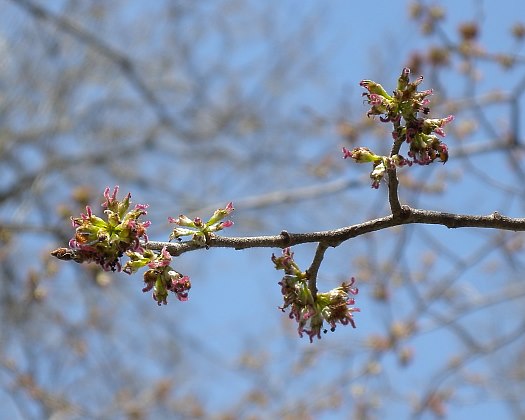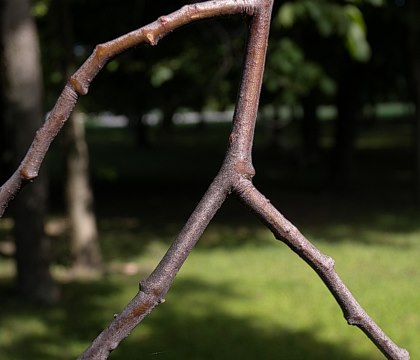Description: This tree is 40-80' tall (rarely taller) at maturity, forming a single trunk about 1-3' across and an ovoid crown that is sometimes flat-topped. The branches are ascending to widely spreading, becoming subdivided into numerous twigs. Trunk bark is predominantly gray, consisting of narrow flat ridges and shallow furrows; inner bark is more reddish brown, as revealed by some of the furrows. The bark of branches and older twigs are more smooth and gray to reddish brown, while the bark of young twigs is reddish brown and hairy. Winter buds at the tips of twigs are brown with reddish hairs. Alternate leaves are 4-6" long and 2-3" across; they are ovate to slightly obovate and doubly serrate along their margins. Leaf venation is pinnate with a central vein and about 12-15 parallel lateral veins. At least 4 lateral veins on each side of the central vein are forked. The upper leaf surface is dull medium green and rough-textured from stiff minute hairs. The lower leaf surface is whitish green and more or less covered with short pubescence. The white ribs of the veins are very prominent along the lower surface. The petioles are about ¼-½" long, light green, and short-pubescent. The leaves are arranged along each twig in two ranks.

The greenish red flowers of Slippery Elm are unisexual or perfect (usually the latter); they are arranged in dense clusters of 5-20 flowers up to 1" across on short pedicels about 1/8" (3 mm.) long. Male, female, and perfect flowers have a short tubular calyx with 5-9 oblong lobes. The calyx is green and hairy; its lobes are erect. Male flowers have 5-9 stamens with reddish anthers, while female flowers have a pistil with a pair of stigmata that are plumose and pinkish red; perfect flowers have both stamens and a pistil. The blooming period occurs from early to mid-spring before the leaves develop; the flowers are wind-pollinated. Fertile female or perfect flowers are replaced by samaras about ½-¾" across. Individual samaras are ovate to orbicular and flattened, consisting of a central seed body that is surrounded by a wide membranous wing. The membranous wings of the samaras are glabrous, while the central seed bodies are hairy. Each samara has a cleft tip that is only slightly notched. The samaras become tan at maturity; they are distributed by the wind during late spring as the leaves develop. The root system is woody and widely spreading. The deciduous leaves usually become dull yellow during the fall.

Cultivation:
Slippery
Elm prefers full sun to medium shade, moist to mesic conditions, and
soil containing loam or clay-loam. It is somewhat vulnerable to Dutch
Elm disease, although less so than American Elm (Ulmus
americana). Growth and development are moderately fast. While
individual trees can live up to 200 years, average life expectancy is
shorter than this because of Dutch Elm and other disease organisms.
Range & Habitat:
The native Slippery Elm is common in Illinois, occurring in every
county (see Distribution
Map). Habitats include rich mesic woodlands, floodplain
woodlands, the lower slopes of wooded bluffs, rocky upland woodlands,
shaded gravelly seeps, riverbanks, edges of limestone glades, thickets,
and disturbed areas along railroads and roadways. In dense deciduous
woodlands, Slippery Elm exists primarily as an understory tree. It
benefits from disturbance that reduces competition from dominant canopy
trees.

Faunal Associations: The caterpillars of the butterflies Nymphalis antiopa (Mourning Cloak), Polygonia comma (Eastern Comma), and Polygonia interrogationis (Question Mark) feed on the foliage of elms (Ulmus spp.), as do the caterpillars of many moths (see Moth Table). The moth caterpillar Bomolocha abalienalis (White-Lined Bomolocha) prefers Slippery Elm as a food source. Several leafhoppers suck juices from the foliage of Slippery Elm (see Leafhopper Table); the leafhoppers Eratoneura affinis, Eratoneura basilaris, Eratoneura bigemina, and Eratoneura bispinosa prefer this tree as a host plant. Other insect feeders include Saperda tridentata (Elm Borer) and other wood-boring beetles (see Wood-Boring Beetle Table), Xanthogaleruca luteola (Elm Leaf Beetle) and other leaf beetles, Eriosoma americana (Woolly Elm Aphid) and other aphids, scale insects, Corythucha ulmi (Elm Lace Bug), the larvae of Cimbex americana (Elm Sawfly), the larvae of Magdalis armicollis (Red Elm Bark Weevil), stinkbugs, and other insects (see Insect Table). Sometimes these insects become sufficiently abundant to seriously damage elm trees. Some vertebrate animals use elms as a food source. Either the seeds or buds are eaten by such birds as the Wood Duck, Wild Turkey, Prairie Chicken, Ring-Necked Pheasant, Carolina Chickadee, Purple Finch, Eastern Goldfinch, Rose-Breasted Grosbeak, Clay-Colored Sparrow, and House Sparrow. The Fox Squirrel, Red Squirrel, and Eastern Chipmunk also eat the seeds. The value of these seeds is increased because they are available during the late spring when mature seeds are in short supply. The sap of Slippery Elm is consumed by the Yellow-Bellied Sapsucker, while the twigs and foliage are eaten by White-Tailed Deer. When Slippery Elm is located near a river or other wetlands, its wood is one of the food sources of the Beaver. Large elm trees, which have become increasing rare, are sometimes used as nesting habitat for such birds as the Red-Shouldered Hawk, Baltimore Oriole, and Warbling Vireo.

Photographic
Location:
A wooded area at Chief Shemauger Park in Urbana, Illinois.
Comments:
With the decline of American Elm (Ulmus americana)
in Illinois, Slippery Elm is now the most commonly encountered tree in
its genus. It can be distinguished from other elms (Ulmus spp.)
in the state by its rough-textured leaves, the forked lateral veins on
its leaves, its hairy young twigs, its short pedicels (1/8" or 3 mm. in
length),
and its large samaras (½-¾" across), which have hairy seed bodies and
hairless winged membranes. The common name of this tree is derived from
its mucilaginous inner bark. Another common is Red Elm.